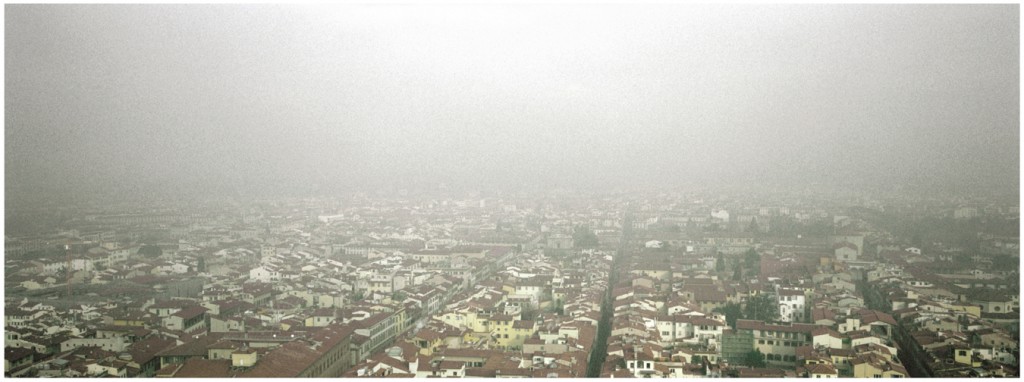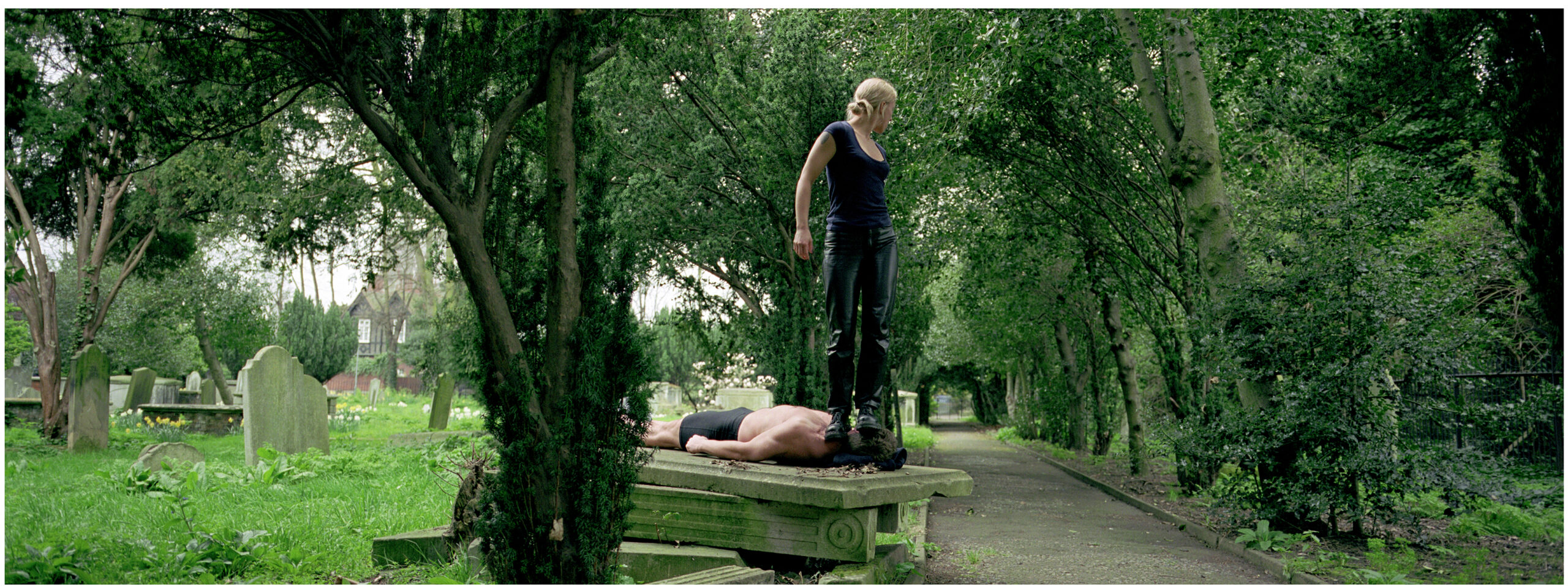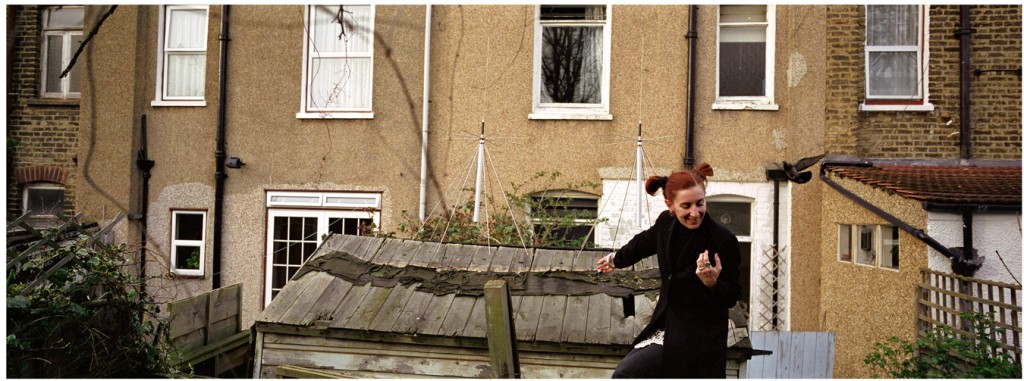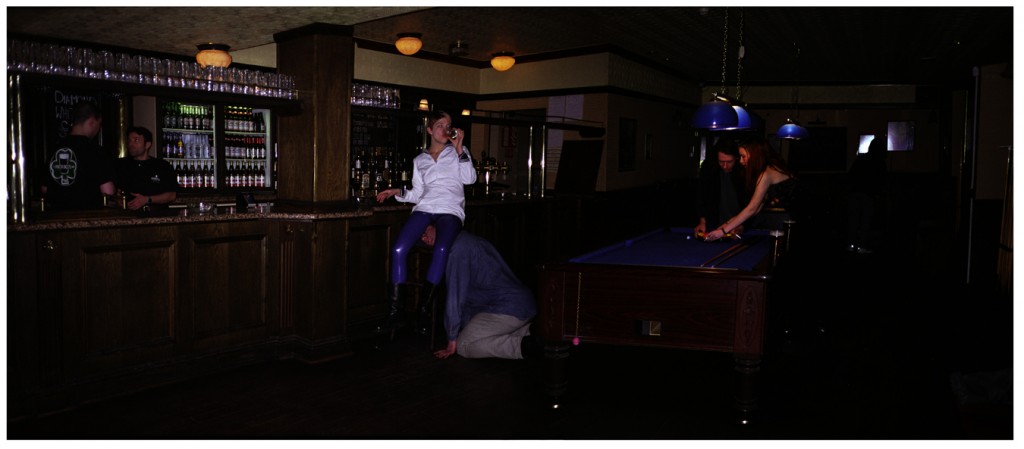
Private Business
First shown at Schaper Sundberg Gallery, Stockholm, Sweden, August October 1999. Public art agency, Sweden bought the two photographs “Corner” and “I Can See You but You Can’t See Me” / “Jag kan se dig men du kan inte se mig” and placed them at the University in Skövde, where they sparked extensive discussion — even involving the Minister of Culture (a long story about art; see below on this page). The photographs are still there.
Another copy of Corner was placed in Umeå at the Department of Gender Studies.
I Can See You but You Can’t See Me / Jag kan se dej men du kan inte se mej was shown in 2011 in the group exhibition Lust och Last at the National Museum in Stockholm, and earlier in the touring exhibition Konstfeminism throughout Sweden (2005–2006), including venues such as Liljevalchs Konsthall. The curator was Niclas Östlind, se bokenKonstfeminism.
Boken och utställningen Konstfeminism fokuserar på olika feministiska strategier i konsten från 1970-talet till idag och lyfter fram konstverk som på olika vis har gett och ger starka avtryck i diskussioner och förhållningssätt till kön, sexualitet, kropp samt mänskliga relationer. Under 1970-talet intog nya tankar och motiv konstscenen på ett banbrytande sätt. Kvinnor utgick från sina egna erfarenheter och lät dessa påverka konsten och debattklimatet — i kontrast till rådande patriarkala värderingar. Det personliga som politiskt område uppmärksammades, samtidigt som det fanns ett starkt engagemang på det globala planet. Även existentiella frågor fick en framskjuten plats.
The large size of the prints is necessary to see all the details. They are analog negatives (Hasselblad panorama camera).
The international egg and spermbank (Analog panorama-negative, C-type print 229X84cm.)
The first photograph, entitled; The International egg and spermbank is of a city and the air space immidiately above it. The air is also an image of an unlimited space, which stems from the fact that many egg and sperm donators and recievers make contact in cyberspace; the collective fertilization space. Cyberspace does not exist as a space, it could however exists as soon as one acts.
(Analog panorama-negative, C-type print ca 229X84cm.)
Title: ”Corner; Athenas emergence” (Pondering the Alliance of Power and Trust between Athena and Zeus)
There is a naked man lying on a gravestone, and a woman standing on his neck, gazing out over the entrance and exit of the cemetery. She has a human heart tattooed on her upper arm.
In relationships, there is a constant negotiation and balancing act between trust and power. The image is titled Corner, because a corner is the supporting part of a building — a place of tension and strength, where forces meet and hold. Private relationships can be both life-giving and life-threatening — hence the cemetery. The action in the photograph expresses power enacted within trust, which is sometimes risky. Yet it is this tension — between vulnerability and control — that forms the foundation of intimacy.
This dynamic mirrors the mythological alliance between Nike, goddess of victory, and Zeus, god of supreme power. Their union is not just one of domination, but of mutual reinforcement: victory needs power, and power is legitimized through victory. In the same way, trust and power in human relationships are not opposites, but interdependent forces.
This dynamic echoes the myth of Athena, born fully formed from the head of Zeus — not in violence, but in a moment of divine insight. Athena, goddess of wisdom and strategy, embodies a power that is not brute force, but reasoned, relational, and just. Her alliance with Zeus is not one of submission, but of mutual reliance: she advises, he listens. Together, they represent a model of power grounded in trust.
In the background, at the top left, there is a building — a library for women’s literature in London. It stands as a quiet counterpoint: a space of knowledge, memory, and resistance.
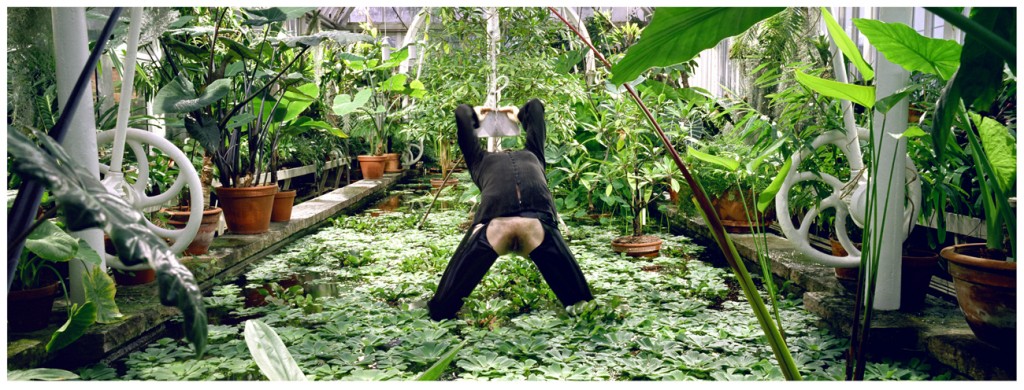 (Analog panorama-negative, C-type print ca 229X84cm.)
(Analog panorama-negative, C-type print ca 229X84cm.)
Title: ”I can see you but you can´t see me.”
”Jag kan se dig men du kan inte se mig.”
A woman — or part of a woman — is embedded in lush green vegetation. Her head is not visible, and her hands form the sign for eyes. The vagina, when exhibited, is as large as a face and looks back at the viewer, saying: “I can see you, but you can’t see me.” The title alludes to The oppositional Gaze (as theorized by Bell Hooks – scroll down and read more about The gaze). The photograph and the title play with the viewer’s gaze reversing the traditional dynamic: the vagina — gender itself — looks back. In doing so, I wanted to question and subvert how women have traditionally been seen. F.x sculptures of nude women in ponds or fountains — naked, but posed in ways that are perceived as gentle, sweet, and beautiful…normative. Here, the vagina is isolated and active; it sees. It is an active female gender. She speaks. She says: I can see you, but you can’t see me. She addresses the viewer, looks back, refusing to be passively observed or studied.
(Analog panorama-negative, C-type print ca 229X84cm.)
”Pondering how to establish communication with my cousin through global information systems — utilizing local area networks, wireless access points, terrestrial cellular towers, submarine fiber-optic cables and satellite relays.”
(Analog panorama-negative, C-type print ca 229X84cm.)
Pondering Power Dynamics at The Blue Angel Bar
This photograph was created at The Angel Bar in London as a performance for the camera. The woman is balancing, trying to find her axis and relax. The man she is sitting on is contemplating his childhood.
This act reverberates through the trembling, shifting, creative structure of society. Society is built on relationships — every private, intimate, and public act by every individual is political.
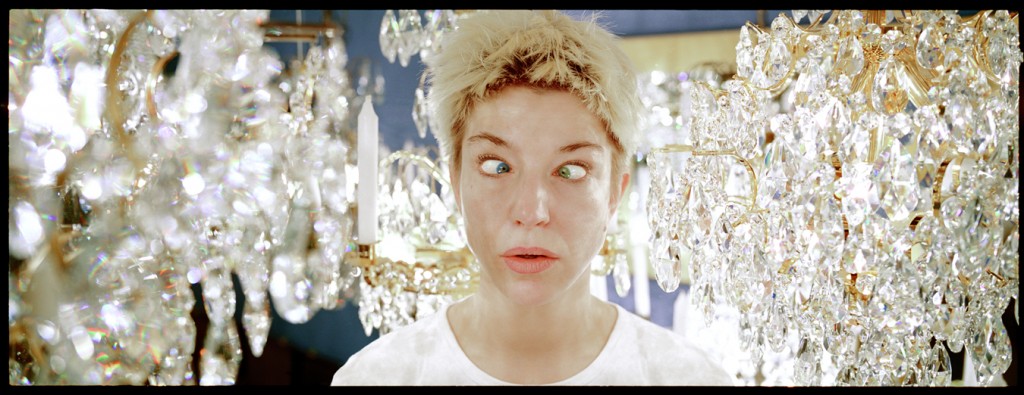 (Analog panorama-negative, C-type print ca 2,5mX1m.)
(Analog panorama-negative, C-type print ca 2,5mX1m.)
I love myself and I understand you think I´m difficult.
The photograph plays with the viewer’s gaze. It is inspired by Jacques Lacan’s theories on subjectivity and the mirror stage.
(Scroll down to read more about the concept of the gaze.)
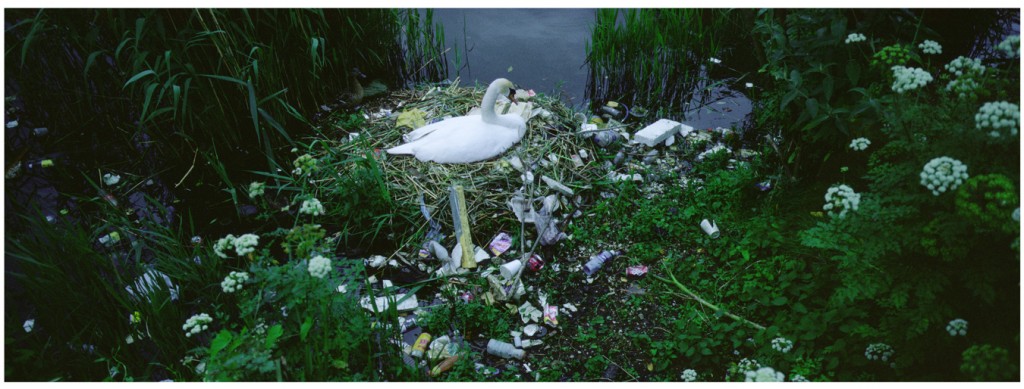 (Analog panorama-negative, C-type print ca 229X84cm.)
(Analog panorama-negative, C-type print ca 229X84cm.)
The Fool
Pondering Socioeconomic Differences
The Fool explores an inevitable — perhaps even necessary — state of mind. To be a fool is to remain open: to the world, to contradiction, to beauty in unlikely places.
A swan lies quietly in the garbage, radiant in its own beauty. It seems foolish to build a nest in such a place — surrounded by waste and ruin — and yet: what do you realise you can do? What can you do? What do you want to do? And what do you actually do?
The image is an invitation to reflect on how we navigate the spaces we inherit, the conditions we’re born into, and the choices we make within them. Foolishness, here, is not ignorance — it is a kind of radical presence.
(C-type print 110 x 70cm) God is love
The photograph was placed at the far end of the gallery. The title appears as a tattoo on her body.
Scarring is a Secret Photo
A documentation of a scarring, accompanied by an explanatory text mounted on the wall. You hold a conception — an ideology, a belief, a position in a political discussion. But sometimes, an experience cuts through the belief behind that conception.
This is how I work.
About The Gaze
The gaze refers to how someone looks at or observes something. It is a concept used to explore how perception is shaped by the act of looking — and how power and identity are mediated and constructed through being seen.
In The Oppositional Gaze: Black Female Spectators (1992), bell hooks explores the gaze from the perspective of the spectator. I have engaged with this concept, aware of how the female body is traditionally viewed through the lens of normative expectations. By reversing the gaze, I aim to question prevailing power structures.
Theories of The Gaze have contributed to a deeper understanding of self-representation and are central to discussions about the role of vision in art and society — especially for visual artists.
Jacques Lacan, psychoanalyst and structuralist, developed the concept of The Gaze around 1956, in the context of his theories on subjectivity and the mirror stage. His ideas explore how individuals perceive and position themselves in relation to others, particularly through the psychoanalytic relationship between the subject and the Other. The gaze of the Other can act as a catalyst for desire, but also lead to a sense of objectification, where the individual internalises the gaze and forms their self-concept through it.
Michel Foucault incorporated the gaze into his theories of power and surveillance. Laura Mulvey introduced the concept of The Male Gaze, and feminist theorists such as Gayatri Spivak, Judith Butler, and bell hooks have expanded it further. Their work offers diverse perspectives on how power and identity are shaped through the dynamics of looking and being looked at.
Photographers can adopt or challenge The Gaze to evoke different emotional and intellectual responses in their viewers.
Så här svarar Kulturministern angående fotot ”Corner” i Skövde.
Fråga för skriftligt svar. Den 20 december
Fråga 2002/03:356 av Yvonne Andersson (kd) till kulturminister Marita Ulvskog om konstnärlig utsmyckning av myndigheter.
Staten byggnader, myndigheter och liknande utsmyckas med stora mängder konst. Konsten ska bidra till en god arbetsmiljö för de människor som arbetar eller vistas i byggnaderna. Konsten köps in av Statens konstråd som ansvarar för den konstnärliga utsmyckningen av samtliga statliga byggnader. Inköpen görs i samverkan med representanter från den myndighet där konsten ska placeras. Självklart är det svårt att göra alla nöjda när det gäller val av konst till en byggnad. Vissa människor kan vara mycket kritiska till en målning eller en skulptur som andra älskar. I vissa fall kan det dock finnas en bred samstämmighet kring ett verk. På Skövde högskola finns i entrén ett målning som många är kritiska till eftersom den ger associationer som inte alla uppskattar. Målningen föreställer en man som ligger på backen, och en kvinna som står på honom. Så många har nu blivit illa berörda av målningen att högskola beslutat att arbeta för att den ska tas bort. Högskolan får dock inte själva ta bort eller flytta den utan detta måste göras i samråd med Statens konstråd. Trots att högskolan tagit kontakt med Statens konstråd och förklarat att de är missnöjda med målningen har inte konstrådet gett dem tillåtelse att flytta målningen.
Vad avser ministern att göra för att öka myndigheternas möjlighet att påverka den konstnärliga utsmyckningen i deras närmiljö?
Svar på fråga 2002/03:356 om konstnärlig utsmyckning av myndigheter. Den 15 januari
Kulturminister Marita Ulvskog.
Yvonne Andersson har ställt frågan till mig vad jag avser att göra för att öka myndighetens möjlighet att påverka den konstnärliga utsmyckningen i deras närmiljö.Frågan är föranledd av en diskussion som förts efter att ett konstverk av Cecilia Parsberg, tidigare professor vid Umeå konsthögskola och en av våra internationellt mest framstående konstnärer idag, blivit placerat av Statens konstråd i entrén till Skövde högskola. Yvonne Andersson menar att många blivit illa berörda av verket och att högskolan beslutat att arbeta för att det ska tas bort, men att Konstrådet inte gett dem tillåtelse att flytta verket.
Jag delar Yvonne Anderssons uppfattning att man ska efterfråga och respektera brukarens uppfattning om de konstverk som ska placeras i den miljö som är en del av deras vardag och jag menar att det är viktigt att finna goda former för samråd så att denna uppfattning på ett lämpligt sett kanaliseras in i beslutsfattandet. Detta samråd bör präglas av öppenhet från alla parter och en ömsesidig respekt för den speciella kompetens man företräder. Men att man, även med, dessa goda förutsättningar, skulle kunna utesluta alla möjligheter till konflikter i ett sammanhang när man diskuterar och beslutar om frågor med koppling till samtidskonsten menar jag är orimligt, om det ens är önskvärt.
Som jag har kunnat inhämta från Konstrådet har de vedertagna samrådsformerna iakttagits i detta projekt. Högskolan i Skövde är ett mindre projekt utan beställda konstverk där man erbjudits möjligheten att föra samrådsdiskussionen genom att verk placerats under en prövotid. Enligt uppgift kommer det nämnda konstverket, som en följd av den diskussion som har förts mellan företrädare för högskolan och Konstrådets projektledare, inte få sin placering i Skövde högskola efter prövotiden. Enligt min uppfattning visar detta att de arbetsformer som Konstrådet praktiserar innebär att brukaren/mottagaren har ett fullgott inflytande över vilka verk som ska placeras i deras arbetsmiljö.
Samtidigt vill jag betona betydelsen av att en verksamhet som Statens Konstråds förmår att föra ut även de senaste och kanske mest krävande konstuttrycken i den offentliga miljön. Detta är en uppgift förenad med vissa uppenbara svårigheter, men som jag menar är central för verksamhetens konstnärliga och kulturpolitiska legitimitet. Dessa konstverk kräver noggranna introduktioner och andra former av uppbackning, men de kräver också ett öppet sinne från mottagarhåll inför det nya och okända.
Det är inte alltid det omedelbara intrycket av ett konstverk som blir det bestående, det är inte heller det mest lättillgängliga och begripliga verket som blir det mest betydelsefulla. Det omedelbara motstånd man kan känna inför något hos ett konstverk kan med tiden visa sig vara det som är dess viktigaste kvalitet. Att betydande samtida konstverk ändå kan visa sig olämpliga att placera i vissa miljöer hör självfallet också till denna bild. Jag har fullt förtroende för Konstrådets förmåga att på bästa sätt hantera dessa svåra avvägningar.
